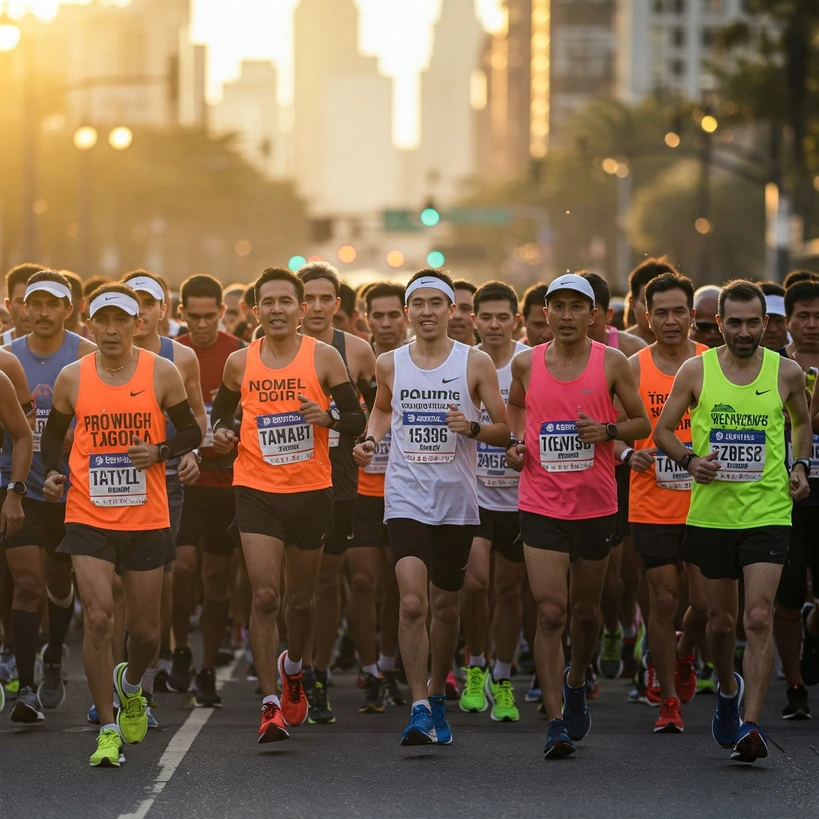The marathon. The very word conjures images of incredible human endurance, cheering crowds, and the ultimate test of a runner’s spirit. It’s an iconic event, a bucket-list goal for millions around the globe. But have you ever stopped to wonder about the distance itself? It’s not a neat, round number like 10k or 50k. The official marathon race distance is a curiously specific 42.195 kilometers, often approximated as 26.2 miles. Why this exact, seemingly random length? The story behind the standard marathon distance is as fascinating as the race itself, winding through ancient legends and, surprisingly, British royal preferences intertwined with early 20th-century logistics.
Let’s unravel the history and significance of this precise measurement and understand why every certified marathon adheres strictly to this specific distance.
What is the Exact Official Marathon Race Distance? (Kilometers vs. Miles)
When we talk about the official marathon distance, precision matters, especially in the world of competitive running. The global governing body for athletics, World Athletics (formerly known as the IAAF), mandates a single, non-negotiable length for all official marathon competitions, including the Olympics, World Championships, and major city marathons like Boston, London, or Tokyo.
That official distance is exactly:
- 42.195 kilometers (km)
This metric measurement is the global standard. Converting this to imperial units gives us:
- 26 miles and 385 yards
Notice it’s not exactly 26.2 miles. While 26.2 miles is the common approximation used widely, especially in countries using the imperial system, the true official equivalent is 26 miles plus that seemingly odd 385 yards. This isn’t just a quirky result of conversion; those 385 yards hold the key to the historical reason behind the distance, as we’ll see shortly. So, while 26.2 miles is convenient shorthand, remember the precise figures – 42.195 km or 26 miles 385 yards – are what count for official records and race certifications.
The Legendary Origins: Was the First Marathon 42.195km?
The marathon’s conceptual roots trace back over two millennia to ancient Greece and the legend of Pheidippides. As the story goes, in 490 BC, after the Athenians defeated the Persians at the Battle of Marathon, the messenger Pheidippides ran all the way from the battlefield of Marathon to Athens to announce the victory, shouting “Nike!” (Victory!) before collapsing from exhaustion.
This heroic tale of endurance is captivating and served as the direct inspiration for the marathon event included in the very first modern Olympic Games in Athens in 1896. However, the distance Pheidippides supposedly ran was roughly 40 kilometers (about 25 miles). While the legend provided the name and the spirit for the race, it did not establish the official marathon race distance we use today. The inaugural 1896 Olympic marathon mirrored this legendary path, covering approximately 40 km, but the specific 42.195 km standard would emerge much later.

Early Olympic Marathons: A Time of Varying Distances
Following the success of the 1896 Athens Games, the marathon quickly gained popularity. Yet, for over two decades, the distance of the Olympic marathon wasn’t fixed. It fluctuated from one Games to the next, likely due to differing course logistics, local preferences, and a lack of formal international standardization.
Consider these early Olympic marathon distances:
- 1896 Athens: ~40 km (approx. 24.85 miles)
- 1900 Paris: ~40.26 km (approx. 25.02 miles)
- 1904 St. Louis: ~40 km (approx. 24.85 miles)
- 1906 Athens (Intercalated Games): ~41.86 km (approx. 26.01 miles)
- 1912 Stockholm: ~40.2 km (approx. 24.98 miles)
- 1920 Antwerp: ~42.75 km (approx. 26.56 miles – the longest Olympic marathon!)
This period of inconsistency highlights that the marathon distance we know today wasn’t pre-ordained but rather evolved through circumstance, leading up to a pivotal event in London.
The Defining Moment: How the 1908 London Olympics Set the Marathon Race Distance
The year 1908 and the London Olympic Games mark the turning point where our modern marathon race distance was born, somewhat by chance. Organizers planned a route starting at the historic Windsor Castle and finishing inside the newly built White City Stadium.
The popular and enduring story attributes the specific distance to the British Royal Family. It’s widely reported that Queen Alexandra requested the race start on the private East Lawn of Windsor Castle, supposedly so the royal children could watch the beginning from their nursery windows. Simultaneously, the finish line was planned to be directly in front of the Royal Box within the stadium, giving the royals a prime view of the race’s conclusion.
However, historical analysis suggests a more complex picture where royal wishes likely combined with practical stadium logistics. While a royal-centric start and finish were desirable, issues arose with the stadium layout. The originally intended entrance for runners (the Royal Entrance) was found to be impractical as it was elevated for carriages and didn’t lead directly onto the track. An alternative entrance, diagonally opposite the Royal Box, had to be chosen.
This change forced a recalculation. The distance from the chosen starting point at Windsor Castle to the new stadium entrance, plus the adjusted partial lap needed inside the stadium to reach the finish line before the Royal Box, resulted in an extra 385 yards being run within the stadium confines. Added to the 26 miles covered on the roads from Windsor, this specific combination of route planning and stadium adjustments serendipitously produced the total distance of 26 miles and 385 yards – which precisely equals 42.195 kilometers.
The 1908 race itself added to the distance’s legacy. The dramatic finish, where Italian runner Dorando Pietri entered the stadium first, only to collapse repeatedly from exhaustion and ultimately be disqualified after receiving help across the line (ceding gold to American Johnny Hayes), captivated the world. This unforgettable human drama significantly boosted the marathon’s profile and likely helped ensure that this peculiar marathon race distance, born from a mix of royal pageantry and logistical problem-solving, wouldn’t be forgotten like the previous variations.
Making it Official: The Standardization of the Marathon Distance
Despite the drama and emerging fame of the 1908 distance, it wasn’t immediately adopted as the universal standard. As seen from the varying distances in the 1912 Stockholm and 1920 Antwerp Games, the London length remained just one iteration for a while longer.
The crucial step towards uniformity came in 1921. In that year, the International Amateur Athletic Federation (IAAF), the body now known as World Athletics, formally codified 42.195 kilometers (the equivalent of 26 miles 385 yards run in London) as the official marathon distance for all future major international competitions. This standard was then consistently applied starting with the 1924 Paris Olympic Games and has remained unchanged ever since.
Why the Exact Marathon Race Distance Matters Today
Maintaining this precise, standardized marathon race distance is paramount in modern athletics for several key reasons:
- Fairness: It ensures that every athlete, whether competing in Tokyo, Berlin, or New York, runs the exact same distance. This creates a level playing field for competition.
- Comparability: A standard distance allows for meaningful comparisons of finishing times across different races, cities, and eras.
- Record Keeping: Official world records, national records, and even personal bests rely on the absolute certainty that the course distance was accurate. World Athletics has stringent rules for course certification to validate records.
- Course Certification: Race organizers must have their courses meticulously measured, typically using the calibrated bicycle method, to ensure they are precisely 42.195 km long. Courses also need to meet criteria regarding elevation drop and the separation distance between start and finish to be eligible for record purposes.
This strict adherence guarantees the integrity of the sport and the validity of every recorded marathon achievement.

The Marathon Distance: A Symbol of Endurance
Today, the marathon race distance is more than just a number. It’s a global symbol of endurance, determination, and personal achievement. It stands as the ultimate test for elite athletes pushing the boundaries of human speed and stamina, and it represents a monumental “bucket list” accomplishment for millions of recreational runners around the world who train for months, even years, to conquer it.
With hundreds of official marathons held annually across the globe, this specific distance fosters a unique international community, connecting runners of all abilities through a shared, challenging goal. Every time a runner toes the line for those 42.195 kilometers, they are not just embarking on a physical challenge, but also connecting to a rich history stretching from ancient Greece to the specific circumstances of the London Olympics over a century ago.
Quick Recap: Marathon Distance Key Facts
For easy reference, here are the essential figures for the official marathon distance:
- Official Metric Distance: 42.195 kilometers
- Official Imperial Distance: 26 miles 385 yards
- Common Approximation: 26.2 miles
- Origin of Current Distance: 1908 London Olympics
- Officially Standardized: 1921 by IAAF (now World Athletics)
Conclusion: The Enduring Legacy of the 42.195km Marathon Race Distance
The journey to the standard 42.195 km marathon race distance is a fascinating tale. It began with inspiration from an ancient legend, went through a period of early Olympic experimentation with varying lengths, and was ultimately solidified by a unique blend of royal circumstance and practical logistics at the 1908 London Games. Formally adopted in 1921, this exact distance – 42.195 kilometers or 26 miles and 385 yards – now stands as a rigorously maintained global benchmark for endurance running. It ensures fair competition, allows for record-breaking achievements, and continues to inspire millions to test their limits against this historically significant and profoundly challenging distance.
Acknowledgements & Further Reading
Thank you for reading this deep dive into the fascinating history and standardization of the official marathon race distance! We hope you found it informative and engaging.
This blog post was compiled based on information gathered from various historical accounts and official athletic resources. If you’d like to delve deeper into the topic, here are a few excellent sources:
- World Athletics: Marathon Discipline Page – Official information from the international governing body for athletics.
- History.com: Why Is a Marathon 26.2 Miles? – A popular historical perspective on the origins of the distance.
- Britannica: Why Is a Marathon 26.2 Miles? – An encyclopedic entry discussing the marathon’s length.
Happy running!

About the Author
Lost Pace is an ultramarathon runner, shoe-tester and the founder of umit.net. Based year-round in Türkiye’s rugged Kaçkar Mountains, he has logged 10,000 + km of technical trail running and completed multiple 50 K–100 K ultras.
Blending mountain grit with data, Lost analyses power (CP 300 W), HRV and nutrition to craft evidence-backed training plans. He has co-written 260 + long-form guides on footwear science, recovery and endurance nutrition, and is a regular beta-tester of AI-driven coaching tools.
When he isn’t chasing PRs or testing midsoles, you’ll find him sharing peer-reviewed research in plain English to help runners train smarter, stay healthier and finish stronger.
Ultrarunner · Data geek · Vegan athlete

